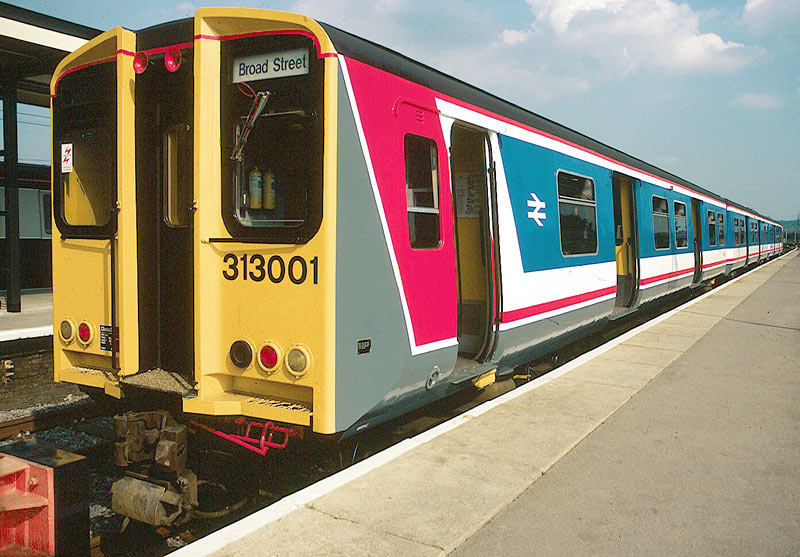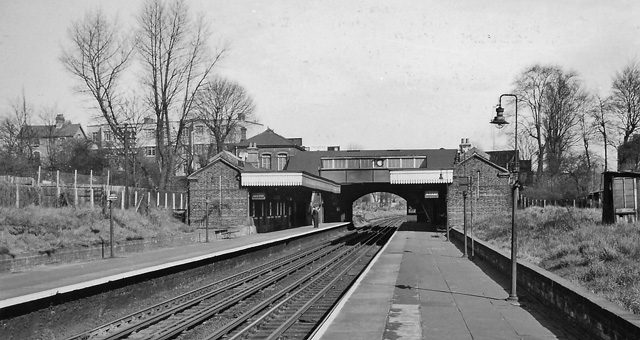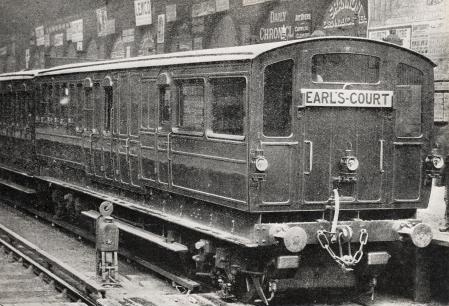|
Silverlink Trains
Silverlink was a train operating company in the United Kingdom owned by National Express that operated the North London Railways franchise from March 1997 until November 2007. At the end of 2007, Silverlink Metro services were taken over by London Overground and Silverlink County services were taken over by London Midland. History The North London Railways franchise was awarded to National Express on 7 February 1997. National Express commenced operating the franchise on 3 March 1997. After initially trading as North London Railways, in September 1997 the franchise was rebranded as Silverlink. The franchise was due to finish on 15 October 2006, but on 11 August 2006 the Department for Transport granted an extension until 10 November 2007. Upon its closure, its London metro services were taken over by London Overground and the remainder were merged with Central Trains' western services to form London Midland. Branding Silverlink had two sub-brands: Silverlink Metro was used fo ... [...More Info...] [...Related Items...] OR: [Wikipedia] [Google] [Baidu] |
British Rail Class 313
The British Rail Class 313 is a class of dual-voltage electric multiple unit, electric multiple units (EMU) passenger trains were built by British Rail Engineering Limited's Holgate Road carriage works between February 1976 and April 1977. They were the first production units that were derived from British Rail's British Rail Classes 445 and 446, 1971 prototype suburban EMU design which, as the BREL 1972 family, eventually encompassed 755 vehicles over five production classes (313, , , and ). They were the first List of British Rail electric multiple unit classes#Second generation, second-generation EMUs to be constructed for British Rail and the first British Rail units with both a pantograph (transport), pantograph for overhead lines and contact shoe equipment for supply. They were, additionally, the first units in Britain to employ multi-function automatic Tightlock coupling, Tightlock couplers, which include electrical and pneumatic connections allowing the coupling and un ... [...More Info...] [...Related Items...] OR: [Wikipedia] [Google] [Baidu] |
Northampton Railway Station
Northampton railway station serves the market town of Northampton in Northamptonshire, England. It is on the Northampton Loop of the West Coast Main Line and is located from London Euston. The station is served by London Northwestern Railway services between London Euston and Birmingham New Street; there is also a limited direct service to Crewe. A handful of Avanti West Coast services also serve the station, but these have been greatly reduced due to the longer-term impact of the COVID-19 pandemic in the United Kingdom. It is the busiest station in Northamptonshire, and the fourth busiest station in the East Midlands. The station was known as Northampton Castle until 1966, as it is built on the site of the former castle of the same name. A proposed reinstatement of the Northampton Castle name following redevelopment of the station in 2015 did not take place. History At one time, there were three railway stations in Northampton: '' Northampton (Bridge Street)'', '' North ... [...More Info...] [...Related Items...] OR: [Wikipedia] [Google] [Baidu] |
West Hampstead Railway Station
West Hampstead is a station on the Mildmay line of the London Overground, located on West End Lane in the London Borough of Camden. Located in Travelcard Zone 2, it is situated between and stations. Two out-of-station interchanges exist with West Hampstead Overground station. One of these is with West Hampstead tube station on the Jubilee line of the London Underground, and the other is with West Hampstead Thameslink station for National Rail services operated by Thameslink. History The station opened on 1 March 1888 and was called West End Lane until 1975, when it became West Hampstead (making it one of three stations of essentially the same name along West End Lane). The train service was provided by the North London Railway until 1909, when management of the NLR was taken over by the London and North Western Railway. Complete amalgamation with the LNWR followed in 1922, and the LNWR then amalgamated with other railways to form the LMS from January 1923. The LMS b ... [...More Info...] [...Related Items...] OR: [Wikipedia] [Google] [Baidu] |
Brondesbury Railway Station
Brondesbury is a station on the Mildmay line of the London Overground. It is situated on a viaduct crossing Kilburn High Road in the Brondesbury area of Kilburn, London, Kilburn in the London Borough of Brent. It is approximately south-east of station and half a mile north-west of station. History Brondesbury station opened on 2 January 1860 as ''Edgeware Road (Kilburn)'' station on the Hampstead Junction Railway. It was renamed several times: ''Edgware Road'' on 1 November 1865, ''Edgware Road and Brondesbury'' on 1 January 1872, ''Brondesbury (Edgware Road)'' on 1 January 1873, ''Brondesbury'' on 1 May 1883. A signal box was in use at the station until 5 February 1962. A number of plans were put forward between 1890 and 1926 to build an Edgware Road Tube schemes, underground railway along the Edgware Road, and would have seen the construction of a Tube station at Brondesbury. None of the schemes succeeded and no such line was ever built. Services All services at Brond ... [...More Info...] [...Related Items...] OR: [Wikipedia] [Google] [Baidu] |
Brondesbury Park Railway Station
Brondesbury Park is a station on the Mildmay line of the London Overground, located in Brondesbury Park in the London Borough of Brent. It is situated in Travelcard Zone 2 and is close to the Queen's Park, London, Queen's Park area. History The Hampstead Junction Railway route between (Low Level) and (via ) opened in 1860, but at first there were no stations west of . The line was absorbed by the London and North Western Railway in 1867, but it was not until 1 June 1908 that a station at ''Brondesbury Park'' was opened. Services All services at Brondesbury Park are operated by London Overground as part of the Mildmay line using Electric multiple unit, EMUs. The typical off-peak service in trains per hour is: * 8 tph to via * 4 tph to * 4 tph to During the late evenings, the services to and from Clapham Junction do not operate. Connections London Buses route 206 serves the station. References External links Excel file displaying National Rail station usage inf ... [...More Info...] [...Related Items...] OR: [Wikipedia] [Google] [Baidu] |
Kensal Rise Railway Station
Kensal Rise is a station on the Mildmay line of the London Overground, situated on Chamberlayne Road, Kensal Rise in north-west London. The station is in Fare Zone 2. History It opened in 1873 as ''Kensal Green'', replacing Kensal Green & Harlesden railway station which opened in 1861 at the crossing of Green Lane (later Wrottesley Road), lying in between the present station and Willesden Junction. The present station was renamed Kensal Rise in 1890. It is close to the newer station built on the Watford DC Line in 1916. Since late 2007 both stations are now served by London Overground, although Kensal Green is managed by London Underground, being additionally served by the Bakerloo line. Services All services at Kensal Rise are operated by London Overground as part of the Mildmay line using EMUs. The typical off-peak service in trains per hour is: * 8 tph to via * 4 tph to * 4 tph to During the late evenings, the services to and from Clapham Junction do not operate. ... [...More Info...] [...Related Items...] OR: [Wikipedia] [Google] [Baidu] |
Bakerloo Line
The Bakerloo line () is a London Underground line that runs between in suburban north-west London and in south London, via the West End. Printed in brown on the Tube map, it serves 25 stations, 15 of which are underground, over . It runs partly on the surface and partly through deep-level tube tunnels. The line's name is a portmanteau of its original name, the Baker Street and Waterloo Railway. From to Harrow & Wealdstone (the section above ground), the line shares tracks with the London Overground Lioness line and runs parallel to the West Coast Main Line. There is, however, a short tunnel at the western end of . Opened between 1906 and 1915, many of its stations retain elements of their design to a common standard: the stations below ground using Art Nouveau decorative tiling by Leslie Green, and the above-ground stations built in red brick with stone detailing in an Arts & Crafts style. It is the ninth-busiest line on the network, carrying more than 125 million pass ... [...More Info...] [...Related Items...] OR: [Wikipedia] [Google] [Baidu] |
Acton Central Railway Station
Acton Central is a station on the Mildmay line of the London Overground, situated between and stations in Travelcard Zone 3. The station is located at the point where Mildmay line trains switch their power supply from overhead line equipment (25 kV AC) to third rail shoes (750 V DC), or vice versa, depending on direction of travel (overhead line is used to Stratford, while third rail is used to Richmond). History The station was opened as ''Acton'' on 1 August 1853 by the North and South Western Junction Railway (N&SWJR), but was renamed ''Acton Central'' on 1 November 1925. The N&SWJR was leased jointly to the London and North Western Railway (LNWR), the Midland Railway (MR) and the North London Railway (NLR) from 1871, but only the NLR operated passenger trains on the N&SWJR until operation of the NLR (and thus of the N&SWJR also) was taken over by the LNWR in 1909. Under the terms of the Railways Act 1921, the LNWR and MR amalgamated (together with some others) a ... [...More Info...] [...Related Items...] OR: [Wikipedia] [Google] [Baidu] |
South Acton Railway Station (England)
South Acton is a station on the Mildmay line of the London Overground, situated in South Acton in the London Borough of Ealing. It is in Travelcard Zone 3. Until 1959 it was also served by the District line of the London Underground. History South Acton station was opened on 1 January 1880 by the North & South Western Junction Railway for North London line trains on the London Broad Street – Richmond line. There was a connecting branch line at South Acton to Hammersmith, renamed Hammersmith and Chiswick from 1 July 1880 and closed from 1 January 1917. There was another branch in the opposite direction from 13 June 1905 to Acton Town, a District Railway service that was withdrawn from 2 March 1959. Branch line from Acton Town Construction A short spur of the District Railway from Acton Town, 1,232 yards (1,126 metres) long, was authorised by the Metropolitan Railway Act of 1874. When first opened, the spur was used for goods trains from 15 May 1899 onwards. Passenger ser ... [...More Info...] [...Related Items...] OR: [Wikipedia] [Google] [Baidu] |
Kew Gardens Station (London)
Kew Gardens is a listed building, Grade II–listed interchange station on the District line of the London Underground and the Mildmay line of the London Overground. Located in Kew in the London Borough of Richmond upon Thames, it first opened in 1869 and is now managed by London Underground. The station, which is in Travelcard London fare zones, Zones 3 and 4, is situated midway between and stations. The station is the nearest to Kew Gardens, about to the west, and The National Archives (United Kingdom), The National Archives, about to the north east. Kew Gardens Station Footbridge, also a Listed building, Grade II-listed structure, is next to the station, on the southern side. Access The main entrance to the station is at the junction of Station Parade, Station Avenue and Station Approach, about from Sandycombe Road (List of B roads in Great Britain, B353). There is also an entrance, which is wheelchair-accessible, on North Road, on the other side of the railway line; th ... [...More Info...] [...Related Items...] OR: [Wikipedia] [Google] [Baidu] |
District Line
The District line is a London Underground line running from in the east and Edgware Road tube station (Circle, District and Hammersmith & City lines), Edgware Road in the west to in west London, where it splits into multiple branches. One branch runs to in south-west London and a short branch, with a limited service, only runs for one stop to . The main route continues west from Earl's Court to after which it divides again into two western branches, to Richmond station (London), Richmond and . Printed in green on the Tube map, the line serves 60 stations (more than any other Underground line) over . It is the only Underground line to use a bridge to traverse the River Thames, crossing on both the Wimbledon and Richmond branches. The track and stations between and are shared with the Hammersmith & City line, and between and and on the Edgware Road branch they are shared with the Circle line (London Underground), Circle line. Some of the stations between and are shared ... [...More Info...] [...Related Items...] OR: [Wikipedia] [Google] [Baidu] |
Richmond Station (London)
Richmond, also known as Richmond (London), is an interchange station in Richmond, Greater London on the Waterloo to Reading and North London lines. It is a western terminus of both the District line of the London Underground and the Mildmay line of the London Overground. South Western Railway services on the Waterloo to Reading Line are routed through Richmond, which is between and St Margarets stations, down the line from . Architecture The station building, designed by James Robb Scott in Portland stone and dating from 1937, is in Art Deco style and its facade includes a square clock. The area in front of the station main entrance was pedestrianised in 2013 and includes a war memorial to soldier Bernard Freyberg, who was born in Richmond. History The Richmond and West End Railway (R&WER) opened the first station at Richmond on 27 July 1846, as the terminus of its line from . This station was on a site to the south of the present through platforms, which later became a ... [...More Info...] [...Related Items...] OR: [Wikipedia] [Google] [Baidu] |








